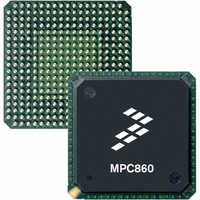MC68360VR25VL Freescale Semiconductor, MC68360VR25VL Datasheet - Page 774

MC68360VR25VL
Manufacturer Part Number
MC68360VR25VL
Description
IC MPU QUICC 25MHZ 357-PBGA
Manufacturer
Freescale Semiconductor
Datasheets
1.MC68EN360VR25L.pdf
(14 pages)
2.MC68EN360VR25L.pdf
(2 pages)
3.MC68360AI25L.pdf
(962 pages)
Specifications of MC68360VR25VL
Processor Type
M683xx 32-Bit
Speed
25MHz
Voltage
3.3V
Mounting Type
Surface Mount
Package / Case
357-PBGA
Family Name
M68000
Device Core
ColdFire
Device Core Size
32b
Frequency (max)
25MHz
Instruction Set Architecture
RISC
Operating Supply Voltage (max)
3.3V
Operating Supply Voltage (min)
2.7V
Operating Temp Range
0C to 70C
Operating Temperature Classification
Commercial
Mounting
Surface Mount
Pin Count
357
Package Type
BGA
Lead Free Status / RoHS Status
Lead free / RoHS Compliant
Features
-
Lead Free Status / Rohs Status
Compliant
Available stocks
Company
Part Number
Manufacturer
Quantity
Price
Company:
Part Number:
MC68360VR25VL
Manufacturer:
Exar
Quantity:
160
Company:
Part Number:
MC68360VR25VL
Manufacturer:
Freescale Semiconductor
Quantity:
10 000
Company:
Part Number:
MC68360VR25VLR2
Manufacturer:
Freescale Semiconductor
Quantity:
10 000
- Current page: 774 of 962
- Download datasheet (4Mb)
Applications
9.6 INTERFACING THE QUICC TO THE 53C90 SCSI CONTROLLER
In the late 1970's, Schugart and Associates introduced a parallel bus called Schugart Asso-
ciates system interface (SASI). Because of SASI's generic nature and ability to function as
a device-independent peripheral or system bus, other manufacturers quickly adopted it. In
1982, ANSI standardized an enhanced version of SASI renaming it the small computer sys-
tem interface (SCSI). Since its standardization as a bus and due to its diverse potential,
SCSI has enjoyed great popularity as an alternative means to network-dissimilar high-per-
formance hosts.
The following paragraphs give a general description of the SCSI bus, including its major sig-
nals and functions. The hardware and software interface between the QUICC and the
53C90 SCSI controller is also discussed. This subsection highlights an example of a QUICC
IDMA channel and the memory controller features that allow the QUICC to interface to
slower peripherals.
9.6.1 SCSI General Overview
SCSI is an 8-bit, parallel I/O bus that provides a host computer with the capability of adding
different disk drives, tape drives, printers, and even communication devices without major
modifications to the system hardware or software. It uses logical rather than physical
addressing for all data blocks.
A maximum of eight devices can be attached to the SCSI bus. Of these eight, only one pair
of devices can communicate at one time. Each SCSI device has an ID bit assigned to it that
is the bit-significant representation of the SCSI address referring to one of the signal lines
DB7–DB0. DB7 has the highest priority. When two devices communicate over the SCSI bus,
one acts as an initiator (host), and the other acts as a target (controller). The initiator origi-
nates the operation, and the target performs the operation.
9.6.2 Physical Interface
The physical bus interface is composed of a group of characteristics: speed, bus signals,
and device count.
Speed, the ability to transfer data, uses two handshaking protocols: synchronous and asyn-
chronous. Synchronous transfers a series of bytes before the handshake occurs; whereas,
asynchronous requires a handshake for every byte transferred. Rates up to 6 Mbytes/sec
can be accomplished asynchronously; 10 Mbytes/sec is possible on the synchronous pro-
tocol.
SCSI devices are daisy-chained using a common cable. This 50-conductor cable is used by
the bus signals to interchange data, commands, status, and message information. Table 9-
1 and Figure 9-17 describe the SCSI bus signals.
9-54
Depending on the assembler used, the acronyms DTT and ITT
may have to be used instead of DAC and IAC.
Freescale Semiconductor, Inc.
For More Information On This Product,
MC68360 USER’S MANUAL
Go to: www.freescale.com
NOTE
Related parts for MC68360VR25VL
Image
Part Number
Description
Manufacturer
Datasheet
Request
R
Part Number:
Description:
Manufacturer:
Freescale Semiconductor, Inc
Datasheet:

Part Number:
Description:
MC68360 MC68360 Multiple Ethernet Channels on the QUICC
Manufacturer:
Motorola / Freescale Semiconductor

Part Number:
Description:
MC68360 Implementing an 8 bit Eprom for an MC68EC040-MC68360 System
Manufacturer:
Motorola / Freescale Semiconductor

Part Number:
Description:
MC68360 Interfacing the MC68060 to the MC68360
Manufacturer:
Motorola / Freescale Semiconductor

Part Number:
Description:
MC68360 MC68360 RAM Microcode Package Option Overview
Manufacturer:
Motorola / Freescale Semiconductor

Part Number:
Description:
MC68360 MC68360 CPM-CPU Interaction
Manufacturer:
Motorola / Freescale Semiconductor

Part Number:
Description:
MC68360 Interfacing SDRAM to the MC68360 QUICC Device
Manufacturer:
Motorola / Freescale Semiconductor

Part Number:
Description:
MC68360 Interfacing the QUICC to a MCM516400 (4Mx4 10-12 column-row) DRAM
Manufacturer:
Motorola / Freescale Semiconductor

Part Number:
Description:
MC68360 Interfacing the 68360 (QUICC) to T1-E1 Systems
Manufacturer:
Motorola / Freescale Semiconductor

Part Number:
Description:
MC68360 Multiple QUICC Design Concept
Manufacturer:
Motorola / Freescale Semiconductor
Part Number:
Description:
Manufacturer:
Freescale Semiconductor, Inc
Datasheet:
Part Number:
Description:
Manufacturer:
Freescale Semiconductor, Inc
Datasheet:
Part Number:
Description:
Manufacturer:
Freescale Semiconductor, Inc
Datasheet:
Part Number:
Description:
Manufacturer:
Freescale Semiconductor, Inc
Datasheet:
Part Number:
Description:
Manufacturer:
Freescale Semiconductor, Inc
Datasheet:











